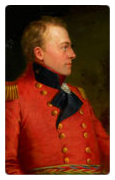The faces of history
September 25, 2012
To heighten visitors’ richly nuanced experience of the War of 1812, the Canadian War Museum is hosting a special Library and Archives Canada exhibition of intimate portraits and striking narrative paintings that complement the Museum’s major exhibition 1812.
Faces of 1812 introduces visitors to famous and lesser-known men and women, both combatants and civilians, whose lives were affected by the war. The exhibition includes, for example, an impressive portrait of civil administrator and military commander Sir Isaac Brock, who became known as “The Hero of Upper Canada” after his death at the Battle of Queenston Heights on October 13, 1812. Also featured is a dramatic painting of Laura Secord, who has just trekked 32 kilometres to warn a British officer about plans she overheard for a surprise American attack. Another poignant image is the solemn portrait of Mrs. John Stuart, which reveals her personal story. After the death in 1811 of her husband, Reverend Doctor John Stuart of Kingston, she and her daughter were left to cope alone with the uncertainties and anxieties caused by the war.
The exhibition also presents some unexpected figures, such as Louis-Joseph Papineau, a Montréal lawyer and politician famous for his role as a radical leader in the Rebellions of Lower Canada in 1837–1838. Few people are aware that Papineau also served as an officer in the 5th Battalion of the Lower Canada militia during the War of 1812.
Displayed in the corridor adjacent to the 1812 exhibition, Faces of 1812 shows how interpretations of the events and personalities of the war have evolved over time. “For example, Laura Secord was not recognized as a heroine in her lifetime,” explains Johanna Mizgala from Library and Archives Canada’s Content Access Branch. “It wasn’t until years after her death that her story entered the public imagination.”
The two institutions consulted closely on how their respective exhibitions could resonate with and play off each other. In fact, 1812 includes material loaned by Library and Archives Canada. “1812 focuses on the validity and consequences of differing points of view,” says Dr. Dean Oliver, Director of Research and Exhibition at the War Museum. “Faces of 1812 is an opportunity for visitors to meet a wide range of people who lived or died during the war. Together, the exhibitions present history on both a grand and an intimate scale.”
Check out a virtual version of Faces of 1812, which includes additional works, on Library and Archives Canada’s website.
Faces of 1812 and 1812 will be on display at the Canadian War Museum in Ottawa until January 6, 2013.